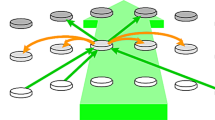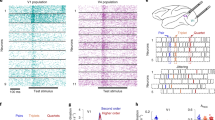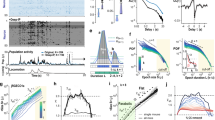Summary
To investigate scene segmentation in the visual system we present a model of two reciprocally connected visual areas comprising spiking neurons. The peripheral area P is modeled similar to the primary visual cortex, while the central area C is modeled as an associative memory representing stimulus objects according to Hebbian learning. Without feedback from area C, spikes corresponding to stimulus representations in P are synchronized only locally (slow state). Feedback from C can induce fast oscillations and an increase of synchronization ranges (fast state). Presenting a superposition of several stimulus objects, scene segmentation happens on a time scale of hundreds of milliseconds by alternating epochs of the slow and fast state, where neurons representing the same object are simultaneously in the fast state. We relate our simulation results to various phenomena observed in neurophysiological experiments, such as stimulus-dependent synchronization of fast oscillations, synchronization on different time scales, ongoing activity, and attention-dependent neural activity.
Similar content being viewed by others
References
Abeles, M. (1982) Local cortical circuits. Springer, Berlin Heidelberg New York.
Aertsen, A., Erb, M. and Palm, G. (1994) Dynamics of functional coupling in the cerebral cortex: an attempt at a model-based interpretation. Physica D, 75: 103–128.
Anderson, J., Lampl, I., Reichova, I., Carandini, M. and Ferster, D. (2000) Stimulus dependence of two-state fluctuations of membrane potential in cat visual cortex. Nature Neuroscience, 3(6): 617–621.
Braitenberg, V. (1978) Cell assemblies in the cerebral cortex. In Heim, R. and Palm, G., editors, Lecture notes in biomathematics (21). Theoretical approaches to complex systems., pages 171–188. Springer-Verlag, Berlin Heidelberg New York.
Braitenberg, V. and Schüz, A. (1991) Anatomy of the cortex. Statistics and geometry. Springer-Verlag, Berlin.
Crick, F. and Koch, C. (1990) Towards a neurobiological theory of consciousness. Sem. Neurosci., 2:263–275.
Eckhorn, R. (1994) Oscillatory and non-oscillatory synchronizations in the visual cortex and their possible roles in associations of visual features. In Pelt, J., Corner, M., Uylings, H., and Lopes da Silva, F., editors, Progress in Brain Research, volume 102, chapter 28, pages 405–426. Elsevier Science BV.
Frien, A., Eckhorn, R., Bauer, R., Woelbern, T., and Kehr, H. (1994) Stimulus-specific fast oscillations at zero phase between visual areas V1 and V2 of awake monkey. NeuroReport, 5(17): 2273–2277.
Hebb, D. (1949) The organization of behavior. A neuropsychological theory. Wiley, New York.
Horn, D., Sagi, D. and Usher, M. (1991) Segmentation, binding, and illusory conjunctions. Neural Computation, 3: 510–525.
Knoblauch, A. and Palm, G. (2001) Pattern separation and synchronization in spiking associative memories and visual areas. Neural Networks, 14: 763–780.
Knoblauch, A. and Palm, G. (2002a) Scene segmentation by spike synchronization in reciprocally connected visual areas. I. Local effects of cortical feedback. Biological Cybernetics, 87(3): 151–167.
Knoblauch, A. and Palm, G. (2002b) Scene segmentation by spike synchronization in reciprocally connected visual areas. II. Global assemblies and synchronization on larger space and time scales. Biological Cybernetics, 87(3): 168–184.
Knoblauch, A. and Sommer, F. (2003) Synaptic plasticity, conduction delays, and inter-areal phase relations of spike activity in a model of reciprocally connected areas. to appear in Neurocomputing.
Markram, H., Lübke, J., Frotscher, M. and Sakmann, B. (1997) Regulation of synaptic efficacy by coincidence of postsynaptic APs and EPSPs. Science, 275: 213–215.
Miller, R., editor (2000) Time and the Brain. Conceptual Advances in Brain research. Harwood Academic Publishers, Amsterdam.
Nelson, J., Salin, P., Munk, M., Arzi, M. and Bullier, J. (1992) Spatial and temporal coherence in corticocortical connections: a cross-correlation study in areas 17 and 18 in the cat. Visual Neuroscience, 9: 21–38.
Neumann, H. and Sepp, W. (1999) Recurrent V1–V2 interaction in early visual boundary processing. Biological Cybernetics, 81: 425–444.
Palm, G. (1980) On associative memories. Biological Cybernetics, 36: 19–31.
Palm, G. (1982) Neural Assemblies. An Alternative Approach to Artificial Intelligence. Springer, Berlin.
Palm, G. (1990) Cell assemblies as a guideline for brain research. Concepts in Neuroscience, 1: 133–148.
Pöppel, E. (1994) Temporal mechanisms in perception. International Review of Neurobiology, 37: 185–202.
Reynolds, J. and Desimone, R. (1999) The role of neural mechanisms of attention in solving the binding problem. Neuron, 24: 19–29.
Ritz, R., Gerstner, W., Fuentes, U. and van Hemmen, J. (1994) A biologically motivated and analytically soluble model of collective oscillations in the cortex. II. Applications to binding and pattern segmentation. Biol. Cybern., 71: 349–358.
Singer, W. and Gray, C. (1995) Visual feature integration and the temporal correlation hypothesis. Annu.Rev.Neurosci., 18: 555–586.
Sommer, F. and Palm, G. (1999) Improved bidirectional retrieval of sparse patterns stored by hebbian learning. Neural Networks, 12: 281–297.
Swadlow, H. (2000) Information flow along neocortical axons. In Miller (2000), chapter 4, pages 131–155.
Treisman, A. (1998) Feature binding, attention and object perception. Phil. Trans. R. Soc. London B, 353: 1295–1306.
Tsodyks, M., Kenet, T., Grinvald, A. and Arieli, A. (1999) Linking spontaneous activity of single cortical neurons and the underlying functional architecture. Science, 286: 1943–1946.
von der Malsburg, C. (1986) Am I thinking assemblies? In Palm, G. and Aertsen, A., editors, Brain Theory, pages 161–176. Springer-Verlag, Berlin/Heidelberg.
Wennekers, T. and Palm, G. (2000) Cell assemblies, associative memory and temporal structure in brain signals. In Miller (2000), chapter 10, pages 251–273.
Willshaw, D., Buneman, O., and Longuet-Higgins, H. (1969) Non-holographic associative memory. Nature, 222: 960–962.
Author information
Authors and Affiliations
Corresponding author
Rights and permissions
About this article
Cite this article
Knoblauch, A., Palm, G. Synchronization of neuronal assemblies in reciprocally connected cortical areas. Theory Biosci. 122, 37–54 (2003). https://doi.org/10.1007/s12064-003-0036-9
Received:
Accepted:
Issue Date:
DOI: https://doi.org/10.1007/s12064-003-0036-9




